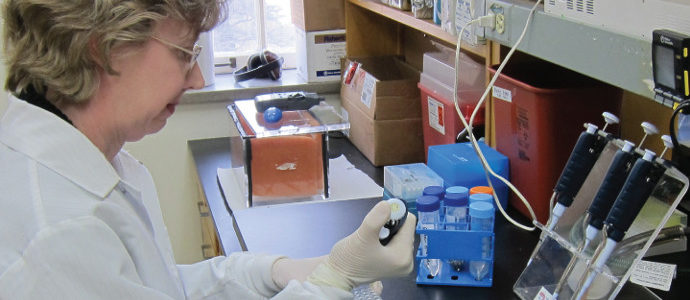The FRAXA Drug Validation Initiative (FRAXA-DVI) provides speedy, cost-effective, objective preclinical testing of potential Fragile X treatments. FRAXA-DVI uses in-vitro systems, behavior batteries, and gene expression and peripheral biomarker platforms to validate investigational new drugs and repurposed available compounds in Fragile X syndrome (FXS).
Read more2011 Grants
Defining Subcellular Specificity of Metabotropic Glutamate Receptor (mGluR5) Antagonists

With $217,500 in grants from FRAXA Research Foundation, Dr. Karen O’Malley and team studied the function of mGluR5 when it is inside cells. Many of the symptoms of Fragile X Syndrome (FXS) are thought to arise due to overactive metabotropic glutamate receptor 5 (mGluR5) signaling, which is normally opposed by the protein missing in FXS, Fragile X Protein (FMRP).
Read morePIKE as a Central Regulator of Synaptic Dysfunction in Fragile X Syndrome

With $255,000 from FRAXA Research Foundation, Dr. Suzanne Zukin at Albert Einstein College of Medicine studied signalling pathways in Fragile X syndrome.
Read moreFragile X Mutant Mouse Models

With $375,000 in grants from the FRAXA Research Foundation since 2009, Dr. David Nelson has developed an impressive array of advanced mouse models of Fragile X, at Baylor College of Medicine. These models are available to investigators worldwide on request. This resource has been essential for a broad, rapid distribution of Fragile X and related gene mouse models and has increased the pace of Fragile X research.
Read moreThe Endocannabinoid System in a Mouse Model of Fragile X Syndrome

With a $128,500 grant over 2011-2013 from FRAXA Research Foundation, Drs. Bradley Alger and Ai-Hui Tang at the University of Maryland researched endocannabinoid pathways in Fragile X.
Read moreInhibitors of STEP as a Novel Treatment of Fragile X Syndrome

With a $349,000 grant from FRAXA Research Foundation from 2008-2015, Dr. Paul Lombroso and his team at Yale University researched if inhibiting STEP could reduce behavioral abnormalities in Fragile X syndrome. Results published.
Read moreFunctional Interplay Between FMRP and CDK5 Signaling
With a $180,000 grant from the FRAXA Research Foundation over 2011-2014, Dr. Yue Feng and Dr. Wenqi Li at Emory University will study CDK5 pathway function and regulation in an effort to break down whether and how CDK5 signaling is affected by the loss of the Fragile X protein, FMRP, in the Fragile X mouse model.
Read moreGlycogen Synthase Kinase-3 (GSK3), Lithium and Fragile X

With $208,000 in funds from FRAXA Research Foundation, Dr. Richard Jope and his team at the University of Miami tested whether newly developed, highly specific inhibitors of GSK3 can reduce behavioral abnormalities in Fragile X mice.
Read moreTreatment of Fragile X Syndrome via Dopamine Enhancers and Glutamate Inhibitors

FRAXA Awards $50,000 in 2011 and $50,000 in 2010 to Patricia Cogram, PhD for treatment of Fragile X syndrome via Dopamine Enhancers and Glutamate Inhibitors. This project aims to follow up our and others observations that the dopamine receptor is under expressed in the Fragile X syndrome and thus determine the effectiveness of targeted pharmacological treatments in Fragile X syndrome.
Read moreSmall Rho GTPases, a Potential Therapeutic Target for Fragile X Syndrome

With $384,345 in grants from FRAXA Research Foundation, Dr. MariVi Tejada from the University of Houston focused on a particularly promising point of intervention in pathways of brain receptors, and tested several potential therapeutic compounds in an attempt to rescue function in the mouse model of Fragile X.
Read moreA Developmental Switch Exists in the Effects of FMRP

With a $90,00 grant from FRAXA Research Foundation for 2010-2011, Dr. Kimberly Huber and her team at the University of Texas at Southwestern found that there is a developmental switch of postsynaptic FMRP on synaptic function. This switch is controlled by MEF2 transcriptional activity. Proper synapse maturation and elimination is crucial for the establishment of appropriate neural circuits that underlie sensory processing and cognition. Neuron of Fragile X patients as well as in the mouse model of Fragile X, Fmr1 KO mice, display more dendritic spines, the point of contact for excitatory synapses, as well as long and thin filopodia resembling immature spines. This suggests Fragile X mental retardation protein (FMRP) has a role in promoting synapse maturation and elimination.
Read moreAb-Mediated Translation in Fragile X Syndrome

With a $120,000 grant from FRAXA Research Foundation during 2011-2012, Dr. Cara Westmark at the University of Wisconsin explored the role of AbPP as a potential treatment option for fragile X. AbPP produces b-amyloid which is over-expressed in Alzheimer’s disease (AD) and Down syndrome.
Read moreGenetic and Pharmacologic Manipulation of PI3K Activity in FXS: Assessing Potential Therapeutic Value

With a $90,000 grant from the FRAXA Research Foundation, Dr. Gary Bassell and his team at Emory University explored the PI3K/mTOR signaling complex in FXS via genetic and pharmacologic rescue approaches, to reduce the enzymatic function of specific components of this complex pathway in an FXS mouse model.
Read moreReward Function in Fragile X Syndrome

With a $82,500 grant from FRAXA Research Foundation in 2011-2012, Dr. Christopher Cowan and Dr. Laura Smith explored the role of specific signaling pathways in drug-related behavioral deficits, including determining the role, if any, of known impairments in the Fragile X brain.
Read moreA Metabolomic Drug Efficacy Index to Test Treatments in the Fragile X Mouse

Dr. Davidovic has been examining changes in metabolism in various brain regions that are affected in Fragile X patients. She has defined a brain-specific metabolic signature of FXS and is testing treatment strategies to restore normal levels of these metabolites.
Read moreInherited Channelopathies in Cortical Circuits of Fmr1 KO Mice

With this two year award of $90,000, Dr. Zhang and Principal Investigator Dr. Andreas Frick at Neurocentre Magendie in France investigated channelopathies using Fragile X mice. Many other proteins are misregulated as a result of the absence of FMRP. It is known that many ion channels, the pores in the cell membrane which allow neurons to conduct electrical impulses, have altered levels in Fragile X. This state is sometime called a “channelopathy” in the pharma world. This group is studying the effect of specific alterations in ion channels, and potential therapeutic effects of drugs which open and close these channels.
Read moreIn Vitro Coherent Network Activity

With a $90,000 grant from FRAXA Research Foundation from 2011-2012, Dr. Juan Bacigalupo at the University of Chile studied the abnormal network dynamics of the brain in Fragile X mice to provide information for future therapeutic drug screening.
Read moreRole of JNK in FMRP Regulated Translation in Fragile X Syndrome

With a $90,000 grant from FRAXA Research Foundation over 2 years, Dr. Michael Wilhelm and his team at the University of Wisconsin studied a protein known as JNK, which is observed to be abnormally regulated in Fragile X. Like FMRP, it is involved in regulating dendritic protein synthesis, and so it may be a target for drug therapy in Fragile X.
Read moreSerotonergic Rescue of Synaptic Plasticity in FMR1 Knockout Mice

With $306,000 in grants from FRAXA Research Foundation, Dr. Julius Zhu from the University of Virginia examined the effects of several drugs such as Buspar and Abilify which manipulate specific serotonin receptors and the effect that has on synaptic plasticity (LTP and LTD).
Read moreEfficient Screening for Pharmaceutical Amelioration of FXS Behavioral Deficits in Drosophila

With a $112,250 grant from FRAXA Research Foundation over 3 years, Dr. Efthimios Skoulakis and his team from the Institute of Cellular and Developmental Biology conducted the first FRAXA project in Greece, where they developed a speedy new test for learning problems in fruit flies, which allowed them to test a number of drugs that are potential Fragile X treatments.
Read moreChannelopathies: Altered Ion Channels in Fragile X Syndrome

With a $95,000 grant from FRAXA Research Foundation from 2010-2011, Dr. Daniel Johnston and Dr. Darrin Brager at the University of Texas at Austin investigated alterations in ion channels in Fragile X syndrome. They explored potential therapeutic effects of drugs which open and close these channels. Results published.
Read moreRole of Excessive Protein Synthesis in the Ontogeny of FXS

With a $90,000 grant from FRAXA Research Foundation in 2010-2011, Dr. Mark Bear and Dr. Miquel Bosch tested the simple hypothesis that the excessive rate of protein synthesis is not a consequence but the primary cause of the structural alterations occurring in Fragile X syndrome.
Read moreAltered Dendritic Synthesis of Postsynaptic Scaffold Protein Shank1 in Fragile X Syndrome

With a $106,800 grant from FRAXA Research Foundation over 2 years, Drs. Stephan Kindler and Hans-Jurgen Kreieinkamp studied a protein, Shank1, which is overabundant in Fragile X syndrome.
Read moreClinical Trials Outcome Measures

With $281,824 in funding from FRAXA Research Foundation from 2002-2011, Dr. Berry-Kravis at the Rush University Medical Center attempted to validate a new automated video tracking system for quantifying physical activity as an outcome measure for Fragile X clinical trials.
Read moreManipulating Basal and mGluR-Stimulated cAMP Level in FXS Model Mice

With a $90,000 grant from FRAXA Research Foundation, Dr. Hongbing Wang’s team from Michigan State University looked at a treatment target “downstream” of the mGluR5 called cyclic AMP (cAMP). Levels of cAMP are lower in FXS patients and animal models, suggesting that it plays a role in FXS. Drugs that raise levels of cAMP may effectively treat Fragile X. We are very pleased to report that, in 2012, Dr. Wang received a 5-year, $250,000 per year R01 grant from NIH to continue this promising research.
Read more
